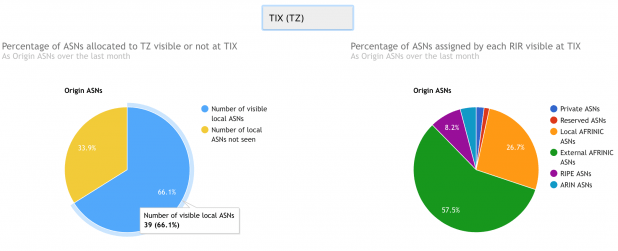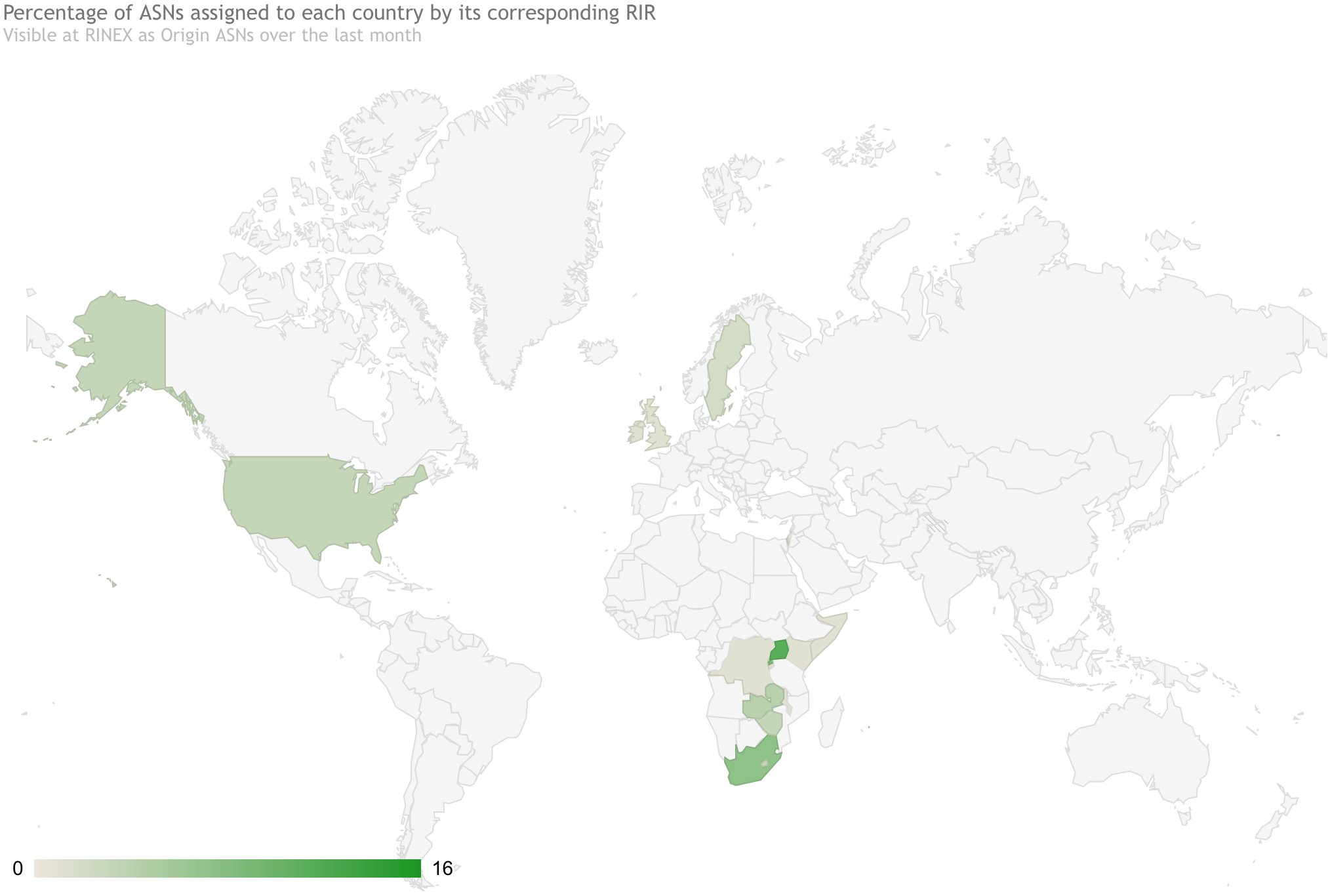Do you want to understand more about how the Internet is connected in Africa? Today we are pleased to announce the African Route-collectors Data Analyzer (ARDA) system. This new systems aims to present data collected at African IXPs in ways that can be easily extrapolated into practical business, policy, developmental, technical, or research opportunities for everyone involved in the peering and interconnection ecosystem.
Background
The African peering and interconnection scene can be traced back to 1996 when the first Internet Exchange Point (IXP) was established in Johannesburg, South Africa. Today, there are 37 IXPs located in 28 African countries. The majority (21) of these IXPs are relatively new, having been established within the past 8 years. This is largely due to a deliberate, concerted, and consistent effort by organizations and individuals from the Internet technical community on extolling the benefits of peering and interconnection, that starts with the establishment of a domestic IXP.
For those involved, it is not a race to boil the ocean, but a journey and an exercise in developing social engineering skills in diplomacy and patience, one country at a time. Along the way, there have been heartwarming success and notable failures. Mistakes have been made and in equal measure, lessons learnt. In all, the journey and efforts continue, with the hope to realizing IXPs and interconnections between the majority of countries in Africa.
However, twenty-one (21) years since the first IXP was established in Africa, the ability to track peering and interconnection growth and evolution has remained relatively challenging or simply not possible in some cases. For stakeholders who play a vital role in Internet development, it is an ongoing struggle to justify commitments, especially when information is based on limited data and intuitions.
What is ARDA?
ARDA was inspired by the lack of progressive, visual, and near real-time data on the status of networks in Africa, from an African internal vantage point. In addition, having easily accessible information that could progressively pinpoint challenges and opportunities, over time, was necessary to monitor progress and gaps. As a colleague once eloquently put it, we need additional information to know how to re-engineer a plane in mid flight.
For instance, knowing that an IXP is exchanging an aggregate of 2 Gigabits per second is useful, but limited in detail. ARDA examines, using publicly available data, which networks are directly connected to that IXP, which networks are indirectly connected through that IXP and how far these (both direct and indirectly) connected networks span in terms of country of origin. ARDA is also able to analyze the percentage of the known networks in Africa, that are actively interconnecting and to identify at which points they are doing so, locally and across the entire region. Simply put, ARDA can present progressive data on the status of interconnection from the view of the IXP in that country. All this information is presented on a freely accessible website, eliminating the need to invest in resources to process huge repositories of raw data to obtain the same information.
ARDA’s analyzed data is collected from two existing Border Gateway Protocol (BGP) route collector projects: The University of Oregon’s Route-views Project and Packet Clearing House’s (PCH) Route Collectors. ARDA collects data from 39 existing route collectors (1 from Route-Views and 38 from PCH) deployed at 23 operational IXPs in Africa. However, not all IXP participants peer with these route-collectors. As a result, ARDA shows lower values of Africa’s peering and interconnection landscape. The computed and displayed statistics are classified into 3 matrix views:
i. The IXP View where we provide several statistics per IXP,
ii. The National View where we display statistics per set of IXPs in the same country, and
iii. The Regional View where we plot statistics computed based on the data from all IXPs in the region
To demonstrate a practical business and development opportunity, we select a matrix view “Number/Percentage of ASNs by Country Assignment” under the IXP View tab for the TIX in Dar es Salaam, Tanzania (Fig. 1). The analysis of the number of Autonomous System Numbers (ASNs) visible at the TIX shows that, at least 66% of the local networks are visible at the local IXP. In addition, the analysis shows that there are a considerable number of African networks (84 ASNs) visible at the TIX. A map visible on the same page (see from website) shows the extent where some of the networks are originating.
This view could be of strategic importance, when helping to understand the reach of networks connected to the TIX, especially when evaluating the TIX as a potential interconnection point. It also promotes TIX as a progressive IXP with both local and regional interconnection, while highlighting 20 ASNs that are not visible – perhaps potential new local peers in Tanzania. At the same time, the information on this view may be of particular interest to progressive out of region networks looking to expand into the East African region. Admittedly there are other factors to consider before making a peering decision, however, it is our belief that the information from ARDA will complement or support other data sources and intuitions.

Fig. 1: Number/Percentage of ASNs by country assignment at TIX
The Regional View takes a closer look into all the ASNs assigned by AfriNIC to networks in Africa. In one matrix view, the analysis shows that, almost 58% of all the networks in Africa are seen at an IXP in Africa (Fig. 2). This is quite an interesting observation considering that ARDA, is only analyzing data collected from 23 IXPs located in 18 countries. It also goes to show that there is good progress in cross-border interconnection, but still much to do considering that only 17% of local ASNs are found to be directly peering at one of the studied IXPs.
Fig. 2: Percentage of ASNs assigned to the region visible at all IXPs in Africa
Appreciation
We would like to recognize the contributions and support of IMDEA Networks Institute, UC3M, PCH, Af-IX, AfriNIC, TIX, UIXP, and INX-ZA for their invaluable assistance in the development of this tool. We also want to specifically recognize Rodérick Fanou (IMDEA Networks Institute and UC3M) and Victor Sánchez-Agüero (IMDEA Networks Institute and UC3M) who were the lead developers of ARDA under the supervision of Francisco Valera(UC3M). There are many others who have made significant contributions to the project. Lastly, we thank the Internet Society and their staff for their support and contribution.
Conclusion and Invitation!
It is our hope that ARDA will not only validate our intuitions, but also expose hidden opportunities across the entire continent.
We hereby invite you to review the ARDA 1.0 tool and provide us with any feedback that you may have. As this represents the initial release of the system, any suggestions to improve, fix, or resolve any inconsistent data would be appreciated.
We are also looking for suggestions on other matrixes that could be derived from the data for your benefit.
Lastly, networks participating at IXPs in Africa are encouraged to peer with the existing route-collectors at their local IXP in order to improve ARDA’s accuracy. ARDA is designed to easily add in and automatically process data from new route-collectors.
Please email any views, suggestions, or bugs to us at arda@inv.it.uc3m.es

